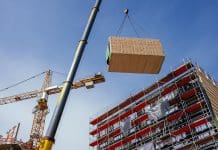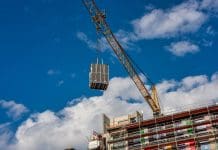Over the next few years, the offsite sector is set to be one of the fastest growing industries. The factors underpinning the growth include an increasing number of public sector procurement frameworks targeted at offsite construction and the need to help meet the chronic housing shortage while coping with the lack of traditional construction skills within the sector
There are many types of offsite construction systems, from fully finished volumetric modules through to open or closed panelised systems and individual component or sub-assemblies that can be successfully combined to harness all the benefits on offer. With many material choices all readily available across the UK, it can be a very complicated and daunting journey into the world of offsite!
With new systems, manufacturers, materials and products popping up almost every day, selecting the best offsite construction system for your needs become increasingly more complicated.
One of the first questions I ask a client is “what is driving your need/want for offsite?”
The answers always vary but often the client’s main drivers are reducing time on site, cost assurance, a higher quality product, increasing labour costs and a reduction in carbon footprint. We all know by now these are just a few of the many benefits of offsite.
Behind the hazy seduction of all the benefits, when we burrow down into what a client wants, the feedback is varied. Some clients have an established team of contractors and a materials supply chain that they want to utilise, and this can lead to a solution that is only partly finished in the factory. Other clients might want fully finished modules supplied to site. In truth, there is no “one size fits all” solution that can be provided, no single panacea.
The skill and expertise needed to help find the optimal offsite system for your project is something we’ve developed over the past 20 years in the industry. Our supply chain partners offer a vast range of manufactured construction solutions and with our help and guidance we work with them to ensure that your project is delivered with maximum efficiency and the right level of finish and pre-assembly.
When should you start thinking about using offsite in your projects?
Unlike traditional construction, offsite solutions need to consider even more design requirements! They need to focus on manufacture and assembly, transport and installation, different CDM and H&S requirements during install and finishing, and even dismantling or moving the building at the end of its life. You will need to “Modularize” your building or project! By incorporating the manufacturing, transport and logistic constraints into the early design and concept planning stages, the optimum solution is developed.
Adding offsite into a project that has secured planning rarely adds value. The key to success is having a complete design team from the outset who understand all the offsite sectors benefits as well as its constraints. The use of offsite construction will affect design choices and decisions. This is not a process that should be added after the design has been finalised.
A well-conceived project from the outset with the appropriate level of offsite element will offer both greater value to the client, enhanced reputation for quality of the project and a competitive advantage in the marketplace.
Invest in time to understand your suppliers and what they are capable of!
In the offsite sector, we are always developing ways to deliver and integrate new solutions or products. Innovation is in our bones, it’s what drives our every thought, but is constantly reaching for blue skies worthwhile for our manufacturers? Surely with one of the most established construction supply chains in the UK we can work collaboratively and build companies from the ground up together.
During my time in the industry, I have been fortunate enough to have spent time with many of the companies driving the innovation within the supply chain. The level of pre-assembled components available is vast. I have found the supply chain for building components incredibly helpful. From technical calculations to 3D modelling these progressive forward-thinking companies are there to help.
Building the correct supply chain network with accredited products and established a track record of delivery is critical. We need to work together. In this digital age the tools surround us. I’ve seen amazing things in my time at Modularize. Building Information Modelling (BIM), Augmented Reality, Artificial Intelligence and even how Blockchain and smart contracts can help to ensure everyone in the supply chain gets paid fairly and on time! I’m inspired and sure that all of this compliments offsite construction perfectly.
Take the WikiHouse for example, this project shows a real collaborative, open source and digitally integrated approach to offsite construction. The nHouse raised hundreds of thousands using online crowdfunding and more recently RETHINK is a project that is emerging as mouth-wateringly promising!
What information do you need to build an offsite project?
Traditionally, an architect will guide your construction project through the RIBA stages. With offsite construction projects the influence of the system used can influence the design subtly or vastly! Without knowing the intricacies of different offsite systems there is a tendency to pigeonhole one form of offsite construction and apply that thinking generally. There are many, many ways to approach an offsite project and knowing the ins and outs of as many offsite systems as possible will give you the edge in ensuring that your project is designed to maximise your return on investment. In order to achieve this, you’ll need to be able to communicate with architects AND manufacturers. You’ll need to bridge the gap, speak the same lingo and understand what type of information and processes each work to.
This is where Modularize comes in. We bridge the gap between architects and manufacturers and we ensure that the optimal level of pre-assembly is applied to your project from the start.
We don’t produce the typical construction drawings you might associate with a conventional project. We produce manufacturing information that can be used to ensure that your tenders are like-for-like and your costs are known with absolute certainty. We achieve this by working collaboratively. Our architectural department will work with your architect or take the project on from conception through planning and ensure that the project is suitable for manufacture. Our manufacturing and engineering department then take over to produce the information that the manufacturers need such as manufacturing drawings and Bills of Materials. With a fully costed Bill of Materials for your projects then you’re also able to drive costs further and understand the impact on application of different levels of pre-assembly from different manufacturers.
So, in summary, if you want to deliver an offsite project then:
- Design for offsite from the onset – from conceptual design stage or outline planning.
- Know what you can already bring to the project in terms of existing supply chain or workforce.
- Understand your manufacturing supply chain and their individual strengths and weaknesses inside out.
- Work collaboratively and digitally with your consultants and manufacturers.
- Ensure that the correct level of information is communicated at every stage of the design and construction processes.
 Gaynor Tennant
Gaynor Tennant
CBDO
Modularize













